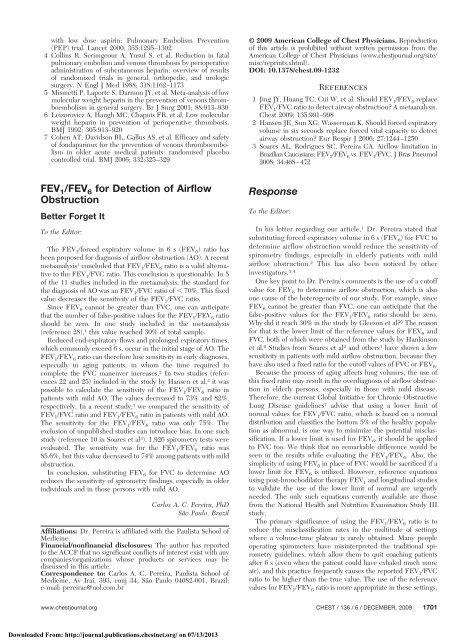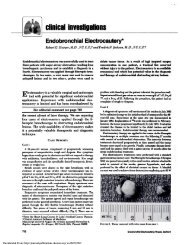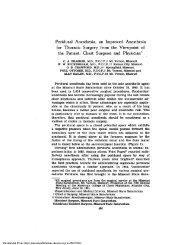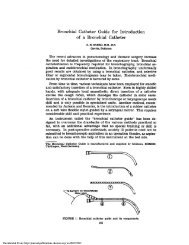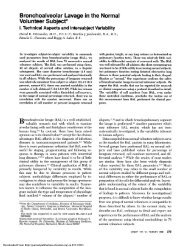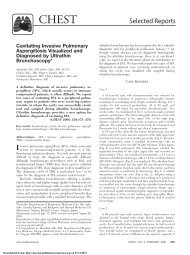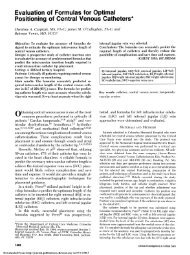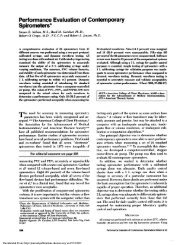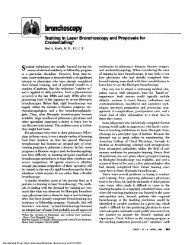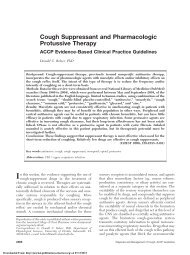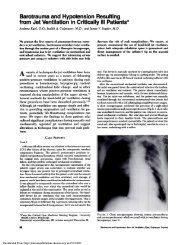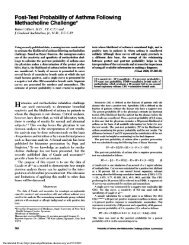FEV1/FEV6 for Detection of Airflow Obstruction Response - Chest ...
FEV1/FEV6 for Detection of Airflow Obstruction Response - Chest ...
FEV1/FEV6 for Detection of Airflow Obstruction Response - Chest ...
Create successful ePaper yourself
Turn your PDF publications into a flip-book with our unique Google optimized e-Paper software.
with low dose aspirin: Pulmonary Embolism Prevention<br />
(PEP) trial. Lancet 2000; 355:1295–1302<br />
4 Collins R, Scrimgeour A, Yusuf S, et al. Reduction in fatal<br />
pulmonary embolism and venous thrombosis by perioperative<br />
administration <strong>of</strong> subcutaneous heparin: overview <strong>of</strong> results<br />
<strong>of</strong> randomized trials in general, orthopedic, and urologic<br />
surgery. N Engl J Med 1988; 318:1162–1173<br />
5 Mismetti P, Laporte S, Darmon JY, et al. Meta-analysis <strong>of</strong> low<br />
molecular weight heparin in the prevention <strong>of</strong> venous thromboembolism<br />
in general surgery. Br J Surg 2001; 88:913–930<br />
6 Leizorovicz A, Haugh MC, Chapuis FR, et al. Low molecular<br />
weight heparin in prevention <strong>of</strong> perioperative thrombosis.<br />
BMJ 1992; 305:913–920<br />
7 Cohen AT, Davidson BL, Gallus AS, et al. Efficacy and safety<br />
<strong>of</strong> fondaparinux <strong>for</strong> the prevention <strong>of</strong> venous thromboembolism<br />
in older acute medical patients: randomised placebo<br />
controlled trial. BMJ 2006; 332:325–329<br />
FEV 1/FEV 6 <strong>for</strong> <strong>Detection</strong> <strong>of</strong> <strong>Airflow</strong><br />
<strong>Obstruction</strong><br />
Better Forget It<br />
To the Editor:<br />
The FEV 1/<strong>for</strong>ced expiratory volume in 6 s (FEV 6) ratio has<br />
been proposed <strong>for</strong> diagnosis <strong>of</strong> airflow obstruction (AO). A recent<br />
metaanalysis 1 concluded that FEV 1/FEV 6 ratio is a valid alternative<br />
to the FEV 1/FVC ratio. This conclusion is questionable. In 5<br />
<strong>of</strong> the 11 studies included in the metaanalysis, the standard <strong>for</strong><br />
the diagnosis <strong>of</strong> AO was an FEV 1/FVC ratio <strong>of</strong> 70%. This fixed<br />
value decreases the sensitivity <strong>of</strong> the FEV 1/FVC ratio.<br />
Since FEV 6 cannot be greater than FVC, one can anticipate<br />
that the number <strong>of</strong> false-positive values <strong>for</strong> the FEV 1/FEV 6 ratio<br />
should be zero. In one study included in the metaanalysis<br />
(reference 28), 1 this value reached 30% <strong>of</strong> total sample.<br />
Reduced end-expiratory flows and prolonged expiratory times,<br />
which commonly exceed 6 s, occur in the initial stage <strong>of</strong> AO. The<br />
FEV 1/FEV 6 ratio can there<strong>for</strong>e lose sensitivity in early diagnoses,<br />
especially in aging patients, in whom the time required to<br />
complete the FVC maneuver increases. 2 In two studies (references<br />
22 and 25) included in the study by Hansen et al, 2 it was<br />
possible to calculate the sensitivity <strong>of</strong> the FEV 1/FEV 6 ratio in<br />
patients with mild AO. The values decreased to 73% and 82%,<br />
respectively. In a recent study, 3 we compared the sensitivity <strong>of</strong><br />
FEV 1/FVC ratio and FEV 1/FEV 6 ratio in patients with mild AO.<br />
The sensitivity <strong>for</strong> the FEV 1/FEV 6 ratio was only 75%. The<br />
exclusion <strong>of</strong> unpublished studies can introduce bias. In one such<br />
study (reference 10 in Soares et al 3 ), 1,926 spirometry tests were<br />
evaluated. The sensitivity was <strong>for</strong> the FEV 1/FEV 6 ratio was<br />
85.6%, but this value decreased to 74% among patients with mild<br />
obstruction.<br />
In conclusion, substituting FEV 6 <strong>for</strong> FVC to determine AO<br />
reduces the sensitivity <strong>of</strong> spirometry findings, especially in older<br />
individuals and in those persons with mild AO.<br />
Carlos A. C. Pereira, PhD<br />
São Paulo, Brazil<br />
Affiliations: Dr. Pereira is affiliated with the Paulista School <strong>of</strong><br />
Medicine.<br />
Financial/nonfinancial disclosures: The author has reported<br />
to the ACCP that no significant conflicts <strong>of</strong> interest exist with any<br />
companies/organizations whose products or services may be<br />
discussed in this article.<br />
Correspondence to: Carlos A. C. Pereira, Paulista School <strong>of</strong><br />
Medicine, Av Iraí, 393, conj 34, São Paulo 04082-001, Brazil;<br />
e-mail: pereirac@uol.com.br<br />
© 2009 American College <strong>of</strong> <strong>Chest</strong> Physicians. Reproduction<br />
<strong>of</strong> this article is prohibited without written permission from the<br />
American College <strong>of</strong> <strong>Chest</strong> Physicians (www.chestjournal.org/site/<br />
misc/reprints.xhtml).<br />
DOI: 10.1378/chest.09-1232<br />
References<br />
1 Jing JY, Huang TC, Cui W, et al. Should <strong>FEV1</strong>/<strong>FEV6</strong> replace<br />
<strong>FEV1</strong>/FVC ratio to detect airway obstruction? A metaanalysis.<br />
<strong>Chest</strong> 2009; 135:991–998<br />
2 Hansen JE, Sun XG, Wasserman K. Should <strong>for</strong>ced expiratory<br />
volume in six seconds replace <strong>for</strong>ced vital capacity to detect<br />
airway obstruction? Eur Respir J 2006; 27:1244–1250<br />
3 Soares AL, Rodrigues SC, Pereira CA. <strong>Airflow</strong> limitation in<br />
Brazilian Caucasians: <strong>FEV1</strong>/<strong>FEV6</strong> vs. <strong>FEV1</strong>/FVC. J Bras Pneumol<br />
2008; 34:468–472<br />
<strong>Response</strong><br />
To the Editor:<br />
In his letter regarding our article, 1 Dr. Pereira stated that<br />
substituting <strong>for</strong>ced expiratory volume in 6 s (FEV 6) <strong>for</strong> FVC to<br />
determine airflow obstruction would reduce the sensitivity <strong>of</strong><br />
spirometry findings, especially in elderly patients with mild<br />
airflow obstruction. 2 This has also been noticed by other<br />
investigators. 3,4<br />
One key point to Dr. Pereira’s comments is the use <strong>of</strong> a cut<strong>of</strong>f<br />
value <strong>for</strong> FEV 6 to determine airflow obstruction, which is also<br />
one cause <strong>of</strong> the heterogeneity <strong>of</strong> our study. For example, since<br />
FEV 6 cannot be greater than FVC, one can anticipate that the<br />
false-positive values <strong>for</strong> the FEV 1/FEV 6 ratio should be zero.<br />
Why did it reach 30% in the study by Gleeson et al? 5 The reason<br />
<strong>for</strong> that is the lower limit <strong>of</strong> the reference values <strong>for</strong> FEV 6 and<br />
FVC, both <strong>of</strong> which were obtained from the study by Hankinson<br />
et al. 6 Studies from Soares et al 2 and others 3 have shown a low<br />
sensitivity in patients with mild airflow obstruction, because they<br />
have also used a fixed ratio <strong>for</strong> the cut<strong>of</strong>f values <strong>of</strong> FVC or FEV 6.<br />
Because the process <strong>of</strong> aging affects lung volumes, the use <strong>of</strong><br />
this fixed ratio may result in the overdiagnosis <strong>of</strong> airflow obstruction<br />
in elderly persons, especially in those with mild disease.<br />
There<strong>for</strong>e, the current Global Initiative <strong>for</strong> Chronic Obstructive<br />
Lung Disease guidelines 7 advise that using a lower limit <strong>of</strong><br />
normal values <strong>for</strong> FEV 1/FVC ratio, which is based on a normal<br />
distribution and classifies the bottom 5% <strong>of</strong> the healthy population<br />
as abnormal, is one way to minimize the potential misclassification.<br />
If a lower limit is used <strong>for</strong> FEV 6, it should be applied<br />
to FVC too. We think that no remarkable difference would be<br />
seen in the results while evaluating the FEV 1/FEV 6. Also, the<br />
simplicity <strong>of</strong> using FEV 6 in place <strong>of</strong> FVC would be sacrificed if a<br />
lower limit <strong>for</strong> FEV 6 is utilized. However, reference equations<br />
using post-bronchodilator therapy FEV 1 and longitudinal studies<br />
to validate the use <strong>of</strong> the lower limit <strong>of</strong> normal are urgently<br />
needed. The only such equations currently available are those<br />
from the National Health and Nutrition Examination Study III<br />
study.<br />
The primary significance <strong>of</strong> using the FEV 1/FEV 6 ratio is to<br />
reduce the misclassification rates in the multitude <strong>of</strong> settings<br />
where a volume-time plateau is rarely obtained. Many people<br />
operating spirometers have misinterpreted the traditional spirometry<br />
guidelines, which allow them to quit coaching patients<br />
after 6 s (even when the patient could have exhaled much more<br />
air), and this practice frequently causes the reported FEV 1/FVC<br />
ratio to be higher than the true value. The use <strong>of</strong> the reference<br />
values <strong>for</strong> FEV 1/FEV 6 ratio is more appropriate in these settings,<br />
www.chestjournal.org CHEST / 136 /6/DECEMBER, 2009 1701<br />
Downloaded From: http://journal.publications.chestnet.org/ on 07/13/2013
since it reduces the misclassification <strong>for</strong> detecting airway obstruction<br />
when compared with using the FEV 1/FVC ratio reference values.<br />
Jiyong Jing, MD<br />
Tiancha Huang, MD<br />
Wei Cui, MD<br />
Hua-hao Shen, MD, PhD, FCCP<br />
Hangzhou, People’s Republic <strong>of</strong> China<br />
Affiliations: Dr. Shen is affiliated with the Department <strong>of</strong><br />
Respiratory Medicine, and Drs. Jing, Huang, and Cui are affiliated<br />
with the ICU in the Second Affiliated Hospital, Zhejiang<br />
University School <strong>of</strong> Medicine, Hangzhou, Zhejiang Province,<br />
People’s Republic <strong>of</strong> China.<br />
Financial/nonfinancial disclosures: The authors have reported<br />
to the ACCP that no significant conflicts <strong>of</strong> interest exist<br />
with any companies/organizations whose products or services<br />
may be discussed in this article.<br />
Correspondence to: Hua-hao Shen, MD, PhD, FCCP, Department<br />
<strong>of</strong> Respiratory Medicine, Second Affiliated Hospital,<br />
Zhejiang University School <strong>of</strong> Medicine, 88 Jiefang Rd, Hangzhou<br />
310009, Zhejiang Province, People’s Republic <strong>of</strong> China;<br />
e-mail: hh_shen@yahoo.com.cn<br />
© 2009 American College <strong>of</strong> <strong>Chest</strong> Physicians. Reproduction<br />
<strong>of</strong> this article is prohibited without written permission from the<br />
American College <strong>of</strong> <strong>Chest</strong> Physicians (www.chestjournal.org/site/<br />
misc/reprints.xhtml).<br />
DOI: 10.1378/chest.09-1767<br />
References<br />
1 Jing JY, Huang TC, Cui W, et al. Should <strong>FEV1</strong>/<strong>FEV6</strong> replace<br />
<strong>FEV1</strong>/FVC ratio to detect airway obstruction? A metaanalysis.<br />
<strong>Chest</strong> 2009; 135:991–998<br />
2 Soares AL, Rodrigues SC, Pereira CA. <strong>Airflow</strong> limitation in<br />
Brazilian Caucasians: <strong>FEV1</strong>/<strong>FEV6</strong> vs. <strong>FEV1</strong>/FVC. J Bras<br />
Pneumol 2008; 34:468–472<br />
3 Demir T. <strong>Response</strong>: utilization <strong>of</strong> <strong>FEV6</strong> in place <strong>of</strong> FVC may<br />
lead to the underestimation <strong>of</strong> mild airway obstruction<br />
[letter]. Respir Med 2005; 99:1617<br />
4 Crapo RO. The role <strong>of</strong> <strong>FEV6</strong> in the detection <strong>of</strong> airway<br />
obstruction [letter]. Respir Med 2005; 99:1467<br />
5 Gleeson S, Mitchell B, Pasquarella C, et al. Comparison <strong>of</strong><br />
<strong>FEV6</strong> and FVC <strong>for</strong> detection <strong>of</strong> airway obstruction in a<br />
community hospital pulmonary function laboratory. Respir<br />
Med 2006; 100:1397–1401<br />
6 Hankinson JL, Odencrantz JR, Fedan KB. Spirometric reference<br />
values from a sample <strong>of</strong> the general US population. Am<br />
J Respir Crit Care Med 1999; 159:179–187<br />
7 Global Initiative <strong>for</strong> Chronic Obstructive Lung Disease. Global<br />
strategy <strong>for</strong> the diagnosis, management, and prevention <strong>of</strong> chronic<br />
obstructive pulmonary disease (updated 2008), 2008. Available<br />
at: http://www.goldcopd.org. Accessed October 29, 2009<br />
Health-Care–Associated Pneumonia<br />
Is Primarily Due to Aspiration<br />
Pneumonia<br />
To the Editor:<br />
In a recent issue <strong>of</strong> CHEST (March 2009), Shindo and coworkers 1<br />
reported the clinical features <strong>of</strong> health-care–associated pneumonia<br />
(HCAP) and the mortality rate among patients hospitalized with HCAP<br />
in Japan. They found that a therapeutic strategy <strong>for</strong> patients with<br />
moderate HCAP holds the key to reducing mortality. Physicians<br />
may need to consider potentially drug-resistant (PDR) pathogens when<br />
selecting the initial empirical antibiotic treatment <strong>for</strong> HCAP.<br />
We completely agree with the authors that the occurrence <strong>of</strong><br />
PDR pathogens is associated with an unsuccessful initial treatment<br />
and inappropriate initial antibiotic treatment. However, the<br />
origin <strong>of</strong> PDR pathogens and the mechanisms underlying HCAP<br />
were not fully described in their article.<br />
Because the average life span <strong>of</strong> individuals has rapidly increased<br />
in developed countries, most <strong>of</strong> the hospitalized patients<br />
with pneumonia are older patients, who are likely to aspirate<br />
oropharyngeal contents during the night without witness. 2,3 In a<br />
previous study, 3 we conducted a swallowing function test and<br />
reported a very high incidence <strong>of</strong> aspiration pneumonia among<br />
hospitalized patients with pneumonia, including communityacquired<br />
pneumonia (CAP) and hospital-acquired pneumonia<br />
(HAP). The criteria <strong>for</strong> the diagnosis <strong>of</strong> HCAP are consistent with<br />
the features <strong>of</strong> aspiration pneumonia. We found that patients<br />
with a history <strong>of</strong> hospitalization <strong>of</strong> 2 days in the preceding 90<br />
days and a stay at a nursing home or extended care facility had a<br />
high risk <strong>for</strong> aspiration pneumonia.<br />
In fact, the data collected by the authors indicated that the<br />
patients with HCAP are older than those with CAP (mean age,<br />
81.3 years vs 69.7 years, respectively). Gram-negative pathogens<br />
and streptococci other than Streptococcus pneumoniae, Pseudomonas<br />
aeruginosa, and methicillin-resistant Streptococcus aureus<br />
were isolated more frequently in HCAP patients than in CAP<br />
patients. Silent aspiration is extremely common in the elderly<br />
patients, and aspiration during the night is the primary cause <strong>of</strong><br />
pneumonia in the elderly. Oropharyngeal materials contain<br />
Gram-negative pathogens and streptococci, which are aspirated<br />
into the lower airways <strong>of</strong> patients with dysphagia. Hence, the<br />
severity <strong>of</strong> pneumonia and the occurrence <strong>of</strong> PDR pathogens<br />
were considerably affected by swallowing dysfunction rather than<br />
the locations where pneumonia had occurred.<br />
Aspiration pneumonia frequently recurs, and it is initially<br />
diagnosed as CAP. However, within the next 90 days <strong>of</strong> hospitalization,<br />
the condition should be diagnosed as HCAP. If not, it<br />
leads to poor prognosis <strong>of</strong> HCAP and a higher number <strong>of</strong> PDR<br />
pathogens in patients with HCAP. Hence, the initial treatment <strong>of</strong><br />
HCAP should be similar to that <strong>for</strong> HAP and ventilator-associated<br />
pneumonia. 4 The Japanese guidelines <strong>for</strong> the management <strong>of</strong><br />
pneumonia recommend a therapeutic strategy <strong>for</strong> aspiration pneumonia<br />
that is very similar to that <strong>for</strong> the management <strong>of</strong><br />
ventilator-associated pneumonia or HAP.<br />
It is important to bear this in mind <strong>for</strong> elucidating a preventive<br />
strategy <strong>for</strong> HCAP. Because aspiration pneumonia is predominant<br />
in patients with HCAP, swallowing rehabilitation and oral<br />
care may prove to be very effective in reducing the incidence <strong>of</strong><br />
HCAP in the future. 5,6 The evidence <strong>of</strong> the effectiveness <strong>of</strong><br />
therapeutic modalities <strong>for</strong> aspiration pneumonia may be applicable<br />
<strong>for</strong> a majority <strong>of</strong> the HCAP patients.<br />
Shinji Teramoto, MD, PhD, FCCP<br />
Masahiro Kawashima, MD<br />
Kosaku Komiya, MD<br />
Shunsuke Shoji, MD, PhD<br />
Tokyo, Japan<br />
Affiliations: Drs. Teramoto, Kawashima, Komiya, and Shoji are<br />
affiliated with the Department <strong>of</strong> Pulmonary Medicine, National<br />
Hospital Organization, Tokyo National Hospital, Tokyo, Japan.<br />
Financial/nonfinancial disclosures: The authors have reported<br />
to the ACCP that no significant conflicts <strong>of</strong> interest exist<br />
with any companies/organizations whose products or services<br />
may be discussed in this article.<br />
Correspondence to: Shinji Teramoto, MD, Department <strong>of</strong><br />
Pulmonary Medicine, National Hospital Organization, Tokyo<br />
National Hospital, 3-1-1 Takeoka Kiyose-shi, Tokyo 204-8585,<br />
Japan; e-mail: shinjit-tky@umin.ac.jp<br />
© 2009 American College <strong>of</strong> <strong>Chest</strong> Physicians. Reproduction<br />
<strong>of</strong> this article is prohibited without written permission from the<br />
American College <strong>of</strong> <strong>Chest</strong> Physicians (www.chestjournal.org/site/<br />
misc/reprints.xhtml).<br />
DOI: 10.1378/chest.09-1204<br />
1702 Correspondence<br />
Downloaded From: http://journal.publications.chestnet.org/ on 07/13/2013


